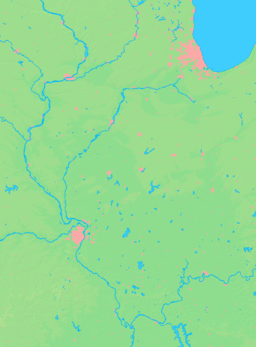Ellsworth, Illinois
| Ellsworth | |
| Village | |
| Country | United States |
|---|---|
| State | Illinois |
| County | McLean |
| Township | Dawson |
| Elevation | 866 ft (264 m) |
| Coordinates | 40°26′58″N 88°42′58″W / 40.44944°N 88.71611°WCoordinates: 40°26′58″N 88°42′58″W / 40.44944°N 88.71611°W |
| Area | 0.23 sq mi (1 km2) |
| - land | 0.23 sq mi (1 km2) |
| - water | 0.00 sq mi (0 km2) |
| Population | 195 (2010) |
| Density | 1,145.7/sq mi (442/km2) |
| Timezone | CST (UTC-6) |
| - summer (DST) | CDT (UTC-5) |
| Zip code | 61737 |
| Area code | 309 |
| FIPS code | 17-23555 |
| GNIS ID | 2398811 |
  Location of Ellsworth within Illinois | |
| Wikimedia Commons: Ellsworth, Illinois | |
| [1][2] | |
Ellsworth is a village in Dawson Township, McLean County, Illinois, United States. The population was 195 at the 2010 Census. It is part of the Bloomington–Normal Metropolitan Statistical Area.
Geography
According to the 2010 census, Ellsworth has a total area of 0.23 square miles (0.60 km2), all land.[3]
History
Founding and Original Design of Ellsworth
Ellsworth was laid out on December 6, 1871 by Jonathan H. Cheney (1833–1920) and Almon Brigham Ives (1816–1887) and Oliver Ellsworth, whom the town was named after.[4] Cheney was one of three sons of early McLean County settler Jonathan Cheney active in promoting the Lafayette Bloomington and Mississippi Railroad; when his brother, Haines Cheney, was in the Illinois Senate he had helped to arrange the charter of the railroad. Almon B. Ives was a Bloomington lawyer specializing in land law; both Jonathan Cheney and Almon B. Ives were on the board of directors of the new railroad. In 1876 the railroad was leased to the Lake Erie and Western Railroad and 1879 was incorporated into that road. Construction began on the railroad in 1869 .The new townsite occupied forty acres on each side of the tracks.[5] The plan of Ellsworth was almost identical to that of Arrowsmith. A two hundred foot swath of railroad land cut the town into two almost equal parts. Most of the early commercial development was along Main Street south of the tracks. The depot was on the south side of the tracks and the early elevator on the north side.[6]
Selling of Ellsworth at Auction.
In November 1871 an advertisement appeared in the Bloomington Pantagraph saying that on November 8 an auction of 150 lots would be held at the site of the new town. The advertisement praised the fertility of the surrounding countryside and stressed that the farms were of moderate size. Readers were told that the new town would be the logical point for shipping grain They were also told that by shipping from Ellsworth their grain would go throughToledo, “avoiding the grain scalpers of Chicago.” All interested people were to gather at the Illinois Central Depot in Bloomington at 9:00 in the morning. A free train would take them to the site of the new town. A free lunch would be provided and Bloomington brewers Meyer and Wochner would provide the beer. Some two hundred people consumed two hundred loaves of bread, one hundred and fifty pounds of boiled ham, sixty barrels of cheese and a barrel of crackers. A. J. Wampler bought the first lot. Most lots sold at from forty to sixty-five dollars.[7]
Development of Ellsworth
Many local merchants were attracted to the new town. John Campbell moved his store from Stumptown about four miles south of Ellsworth. Stumptown was soon totally abandoned. Edwards and Wampler moved their stock from a store in rural Blue Mound Township and were soon reported to be doing a thriving trade;[8] Wampler became the first post master. Henry Vandervoort and Joseph Pierce opened a hardware store in 1873. August Flint had a wagon shop. The town founders donated, “a good lot,” for a church. In 1872 regular freight service began along the new railroad. Many new houses were built. Grain was soon being purchased and shipped. History of McLean County, Illinois[9] After a brief boom the population soon exceeded two hundred, but growth soon slowed.
Demographics
| Historical population | |||
|---|---|---|---|
| Census | Pop. | %± | |
| 1880 | 168 | — | |
| 1930 | 261 | — | |
| 1940 | 255 | −2.3% | |
| 1950 | 199 | −22.0% | |
| 1960 | 224 | 12.6% | |
| 1970 | 259 | 15.6% | |
| 1980 | 244 | −5.8% | |
| 1990 | 224 | −8.2% | |
| 2000 | 271 | 21.0% | |
| 2010 | 195 | −28.0% | |
| Est. 2015 | 194 | [10] | −0.5% |
| Decennial US Census | |||
As of the 2000 United States Census, there were 271 people, 92 households and 72 families, residing in the village. The population density was 1,145.7 inhabitants per square mile (442.4/km2). There were 95 housing units at an average density of 401.6 per square mile (155.1/km2). The racial makeup of the village was 94.10% White, 0.37% African American, 2.95% Native American, 1.11% from other races, and 1.48% from two or more races. Hispanic or Latino of any race were 1.48% of the population.
There were 92 households, out of which 44.6% had children under the age of 18 living with them, 70.7% were married couples living together, 6.5% had a female householder with no husband present, and 21.7% were non-families. 19.6% of all households were made up of individuals and 6.5% had someone living alone, who was 65 years of age or older. The average household size was 2.95 and the average family size was 3.43.
In the village, the population was spread out with 31.7% under the age of 18, 9.2% from 18 to 24, 28.4% from 25 to 44, 21.0% from 45 to 64, and 9.6% who were 65 years of age or older. The median age was 33 years. For every 100 females, there were 93.6 males. For every 100 females age 18 and over, there were 88.8 males.
The median income for a household in the village was $45,714 and the median income for a family was $53,333. Males had a median income of $32,237 versus $24,688 for females. The per capita income for the village was $18,439. None of the families and 1.5% of the population were living below the poverty line.
See also
References
- ↑ "Village of Ellsworth". Geographic Names Information System. United States Geological Survey. February 28, 2008. Retrieved January 24, 2009.
- ↑ "American FactFinder". United States Census Bureau. Retrieved January 24, 2009.
- ↑ "G001 - Geographic Identifiers - 2010 Census Summary File 1". United States Census Bureau. Retrieved 2015-08-03.
- ↑ Historical Encyclopedia of Illinois and History of McLean County (Chicago: Munsell, 1908) p. 902.
- ↑ William D. Walters, Jr., “Town-Making in Eastern McLean County: A Geographic Microstudy,” Bulletin of the Illinois Geographical Society (Fall 1998) LX:2, pp. 19-39.
- ↑ Combined Indexed Atlas, 1856-1914, McLean County, Illinois (Bloomington: McLean County Historical Society and McLean County, Genealogical Society, 2006) p. 161.
- ↑ Walters, 1998, 27 29.
- ↑ Walters, 1998, pp. 28-29.
- ↑ (Chicago: LeBaron, 1879) p. 658.
- ↑ "Annual Estimates of the Resident Population for Incorporated Places: April 1, 2010 to July 1, 2015". Retrieved July 2, 2016.